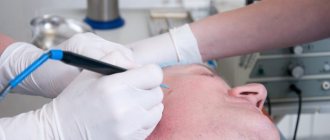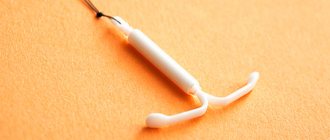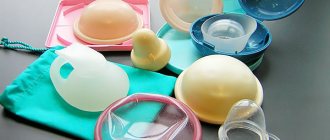Endometriosis is a chronic, progressive disorder characterized by the growth of the endometrium in areas of the body where the tissue should not exist. In most cases, the endometrium appears on the fallopian tubes and ovaries. It can cause pain, inflammation and the development of scar tissue. Endometriosis cannot be completely eliminated, but with the help of some proven remedies, women can sometimes manage its symptoms effectively. These devices include intrauterine devices.
According to the Endometriosis Foundation of America, at least 200 million women around the world have endometriosis, which is confirmed by an official medical diagnosis. The organization's experts note that in the United States, this problem worries every tenth woman.
Common symptoms of endometriosis include the following:
- acute spasms;
- heavy periods;
- prolonged menstrual bleeding;
- pain during sexual activity (dyspareunia);
- disorders of the intestines or genitourinary system;
- nausea or vomiting;
- infertility.
Doctors don't know the exact cause of endometriosis, but experts link the disease to the female sex hormones estrogen and progesterone.
Therefore, one of the therapeutic strategies offered to patients with endometriosis involves taking hormone replacements, which are supplied to the pharmaceutical market in the form of tablets, patches and injection solutions. Hormonal levels can also be influenced using intrauterine devices (IUDs).
In the current article, we will look at the use of IUDs for the treatment of endometriosis.
Indications for the use of Mirena for endometriosis
The intrauterine hormonal system is prescribed for the following conditions:
- Internal endometriosis (adenomyosis) – damage to the body of the uterus;
- External endometriosis - damage to the ovaries, fallopian tubes, peritoneum and other pelvic organs.
The Mirena intrauterine hormonal system is recommended for internal and external endometriosis.
Conditions for placing an intrauterine device (IUD):
- Clinically pronounced disease. The intrauterine system is recommended for confirmed endometriosis, accompanied by pain in the lower abdomen and menstrual irregularities;
- Previous births. Mirena is extremely rarely given to nulliparous women;
- The woman does not plan to conceive a child in the coming years. Mirena is an intrauterine contraceptive. The Pearl index of the system is less than 1. It prevents the conception and bearing of a child. If a patient is planning a pregnancy immediately after suppressing the growth of endometriosis foci, she should choose other hormonal agents;
- There are no signs of inflammation in the vagina and cervix. The IUD is inserted only after sanitization of the genital tract;
- One sexual partner. The intrauterine device does not protect against sexually transmitted infections.
The therapeutic coil is placed not only for endometriosis, but also for combined pathologies. The introduction of a hormonal IUD is practiced for subserous and interstitial uterine fibroids.
For subserous and interstitial uterine fibroids, the use of the Mirena intrauterine hormonal system is also practiced.
The instructions for use of the drug state only one indication - contraception. But clinical studies show that the Mirena spiral is effective for internal and external endometriosis. Its use is possible after a full examination by a gynecologist and under the constant supervision of a doctor.
Hormonal IUD against menopausal diseases
Sex hormones take part in many processes occurring in the female body. With the onset of menopause, their levels decrease and unpleasant symptoms appear.
If, despite a decrease in estrogen production, its level significantly exceeds the level of progesterone, then endometrial hyperplasia, endometriosis, uterine fibroids and uterine bleeding may develop. We will dwell on all the diseases described in more detail.
Endometrial hyperplasia
With a high estrogen content in the body and an insufficient amount of progesterone, endometrial hyperplasia begins - endometrial cells grow. With the development of such a pathology, a woman is bothered by the following symptoms that reduce her quality of life: pain in the lower abdomen and spotting.
If the disease is not treated, the process of malignancy of pathological cells and the development of endometrial cancer, which is very difficult to treat, may begin.
Installing the Mirena IUD helps reduce the effect of estrogen on the endometrium due to the fact that progesterone will be released locally - into the uterine cavity.
At the same time, estrogens will continue to have a positive effect on bone tissue, preventing the development of osteoporosis. Also prevent high blood pressure, frequent urination and dry skin.
Endometriosis
With endometriosis, the endometrium grows beyond the uterus. In the early stages, the disease is asymptomatic, and then menstrual irregularities, heavy periods and pain appear.
In its advanced form, the disease leads to the development of infertility. The disease requires complex therapy, which includes insertion of the Mirena IUD into the uterine cavity.
Myoma
Uterine fibroids are the development of a hormone-dependent benign formation in the muscular layer of the uterus or its cervix. There are 3 main forms of the disease and several combined varieties.
The Mirena IUD is included in the complex treatment of certain forms of the disease. It is inserted into the uterus in order to reduce the influence of estrogen, which provokes the growth of fibroids.
Uterine bleeding during menopause
With the onset of menopause, a woman may begin to experience severe bleeding, with an unknown nature of its origin. They are called metrorrhagia and are very difficult to stop. For this purpose, the Mirena IUD is inserted into the uterine cavity. The effect will not be immediate, but after some time the woman will be able to return to a normal way of life.
Benign tumor
The presence of benign tumors in the mammary glands is not a contraindication to the installation of the Mirena coil. Benign formations that develop in the mammary glands include: adenoma, consisting of glandular epithelial cells, and fibroadenoma, formed from glandular and fibrous tissue.
The Mirena IUD releases levonorgestrel in small doses, and it works in the uterine cavity. The hormone practically does not enter the general bloodstream. Therefore, it has no side effects on the organs and systems of the body, including the mammary glands.
Drugs used to treat benign breast formations combine well with the Mirena spiral. The IUD does not affect the course of the disease or the therapy used.
Advantages and disadvantages of the hormonal system
The hormone IUD has advantages over other medications:
- Life time. An IUD is placed once every 5 years. The cost of Mirena is 10-14 thousand rubles, but the price is worth it. A woman spends about 200 rubles a month on treatment. This is significantly less than when using other drugs;
- Low dosage of the hormone. The IUD releases only 20 mcg of levonorgestrel daily. The drug immediately enters the uterine cavity and does not pass through the gastrointestinal tract. The likelihood of systemic effects on the body is lower than when taking other hormonal drugs. Overdose is impossible;
- Reliable contraception. Mirena changes the structure of the uterine mucosa, increases the viscosity of cervical mucus and interferes with the advancement of sperm. In some women, levonorgestrel suppresses ovulation. There is no need to think about additional contraception during treatment.
Mirena is considered one of the most reliable means of contraception.
Mirena's motto: “Set it and forget it.” You no longer have to think about how not to miss a pill. There is no need to give injections every month. You should only visit your doctor regularly - once a year or more often if indicated for a follow-up examination.
Disadvantages of the IUD:
- It can only be placed and removed by a doctor. You cannot introduce or remove the drug yourself without a special tool;
- Involves interference in the uterine cavity and can lead to the development of aseptic inflammation;
- Increases the risk of genital tract infection;
- Sometimes it interferes during sex. If the partner feels the threads of the spiral during sexual intercourse, they need to be trimmed. The problem can be easily resolved by visiting a doctor;
- Not suitable for women planning pregnancy in the next year. Mirena can be removed at any time, but if a woman is not inclined to use it for several years, it is better to change the drug;
- Has an abortifacient effect. Mirena does not suppress ovulation in all women, and it is possible to conceive a child. But the IUD prevents implantation of the fertilized egg, and a miscarriage occurs. Due to moral convictions, the IUD is not suitable for every woman;
- Long adaptation period – up to 6 months. Unpleasant side effects in the first six months after the introduction of the spiral often become a reason to discontinue the drug;
One of the negative aspects of using the Mirena IUD may be a long-term adaptation to the contraceptive with pain.
- Temporary effect. After removal of the IUD, relapse of the disease is possible.
Use during menopause
At the beginning of menopause, the intrauterine device performs two functions at once: it restores hormonal balance and protects against conception. When the ovaries are still functioning, pregnancy remains possible. But during this period it is difficult to immediately notice signs of conception, because the symptoms during menopause are similar to those experienced by a woman in the early stages of pregnancy.
Menstrual bleeding stops, you feel dizzy, and attacks of nausea occur in the morning and throughout the day. Pressure changes, as well as rapid and slow heartbeat, and swelling are not uncommon. Therefore, by the time the patient notices pregnancy, it may be too late to take any measures. It is better to avoid such situations, because in old age there is a very high probability of a child being born with severe congenital pathologies.
Tests in older women do not always give reliable results, because detection of pregnancy is based on the determination of hCG - human chorionic gonadotropin. The content of this hormone increases in pregnant women, but during menopause it can also be higher than normal.
The use of mechanical contraceptives allows you to have sex without worrying about pregnancy. Unlike hormonal drugs, the IUD does not have a negative effect on well-being. The installed Mirena does not interfere, does not require care or adjustments to your usual diet and lifestyle. The spiral has been used for several years. During this time, minimal supervision is required. There is a small chance that it will move, but such cases are rare.
The uniqueness of Mirena is that it contains artificial progesterone. Entering the body in small doses, it helps normalize hormonal balance. Thus, the system is indispensable when it comes to balancing estrogens and progestins.
How does an IUD work for endometriosis?
The active ingredient of the drug is levonorgestrel. This is a synthetic analogue of progesterone that affects the condition of the uterus and other reproductive organs. The action of Mirena is comparable to other gestagenic agents.
Effects of the intrauterine treatment system:
- Affects the tissue receptor apparatus: reduces sensitivity to endogenous hormones;
- Changes the structure of the uterine mucosa and makes it resistant to estradiol;
- It has an antiproliferative effect: it inhibits the growth of endometriosis foci and prevents the formation of new heterotopias.
The intrauterine hormonal system acts primarily on the mucous membrane of the uterus, and is more often used for internal endometriosis (adenomyosis). For external endometriosis, Mirena is installed after surgery to remove the lesions.
The Mirena intrauterine hormonal system is installed, as a rule, for internal endometriosis.
Complications from incorrect installation of Mirena
If the Mirena IUD is installed incorrectly, the following complications may occur:
- Exacerbation of infectious diseases of the genital tract. It occurs when an infection from the vagina spreads to the lining of the uterus.
- IUD prolapse either completely or partially. In such cases, it is necessary to install a new spiral. In case of partial prolapse, the gynecologist must remove the remains of the intrauterine contraceptive from the uterine cavity. To make sure that everything has been removed, the woman is sent for an ultrasound of the pelvic organs.
- Uterine perforation is the most difficult complication. An inexperienced gynecologist may puncture the uterus during installation of the IUD. It is very difficult to immediately detect a puncture. The spiral can exit through the resulting hole outside the uterine cavity and stop performing its function.
To remove the IUD that is lost in the pelvis, you will need to perform a surgical operation.
Is Mirena effective?
Reviews from doctors about the use of the drug are mixed. Not all gynecologists believe that inserting an IUD is justified in the long term. There is no reliable evidence that Mirena effectively suppresses the spread of endometriosis. The drug is inferior in its effect to other representatives of hormonal drugs - gonadotropin-releasing hormone agonists, drugs based on dienogest. Levonorgestrel only temporarily suppresses the growth of heterotopias. After removal of the IUD, the disease returns quite quickly. Relapse is possible a year after completion of therapy.
Practicing gynecologists note that Mirena is good as symptomatic therapy. With the IUD, the woman’s condition improves:
- The volume and duration of menstrual flow decreases. Some women experience amenorrhea - a complete absence of menstruation;
- Intermenstrual bleeding stops;
- The intensity of the pain syndrome decreases;
- The risk of developing uterine bleeding is reduced.
The use of Mirena helps reduce the volume of menstruation.
Mirena helps treat anemia, a condition in which the level of hemoglobin and red blood cells in the blood decreases. With the IUD, the volume of blood loss decreases and red blood counts are restored. Habitual weakness goes away and performance increases. 3-4 months after insertion of the IUD, a woman can stop taking iron supplements to correct anemia.
It is important to know
Anemia is diagnosed by a blood test. The doctor can stop iron-containing drugs after obtaining good results. You cannot stop taking the medicine yourself, based only on subjective sensations. With prolonged anemia, the body adapts to new conditions, and often the disease is asymptomatic.
In what situations does Mirena not work on endometriosis lesions?
- Adenomyosis III-IV degree;
- Large endometriotic ovarian cysts;
- Multiple foci of endometriosis in the pelvic cavity.
It is also useful to read: What you can and cannot do if you have endometriosis
In advanced situations, the hormonal system is ineffective. Mirena cannot cope with large lesions and widespread process. It is necessary to take other drugs - dienogest, gonadotropin-releasing hormone agonists (Gn-RH). After a course of therapy with strong drugs, Mirena can be installed for several years. Levonorgestrel will suppress the growth of remaining lesions and prevent relapse of the disease.
Mirena is ineffective in localizing multiple endometriotic lesions in the pelvic cavity.
The effectiveness of Mirena also increases after surgical treatment. First, the doctor removes areas of endometriosis in the ovaries, fallopian tubes and peritoneum. After laparoscopy, an intrauterine device is installed. This scheme allows you to remove the largest lesions surgically and suppress the growth of remaining heterotopias conservatively.
On a note
Mirena is not used as a means to prevent endometriosis. There is no reliable evidence that the use of an intrauterine hormonal system in healthy women prevents the development of pathological lesions in the future. It can be assumed that Mirena delays the time of manifestation of the disease. COCs and oral gestagens have the same effect.
A few words about the disease.
Endometriosis of the uterus is a disease characterized by the formation of pathological foci in various organs (uterine muscular lining, fallopian tubes, peritoneum, ovaries, intestines, uterine ligaments, lungs, conjunctiva, nasal mucosa, brain, etc.)
In women of reproductive age, these formations consist of cells that are similar in composition to the cellular composition of the endometrium.
They, like the endometrium, are susceptible to sex hormones, and the same changes occur in them during the menstrual cycle.
The occurrence of such heterotopias in various organs causes the main symptoms of the disease:
- pain in the lower abdomen is either permanent or associated with menstruation;
- various menstrual disorders;
- prolonged bleeding before and after menstruation;
- infertility.
Preparing to install an intrauterine device
Before installing an intrauterine device, you need to undergo examination:
- Examination by a gynecologist. The doctor assesses the condition of the external and internal genital organs, identifies contraindications for the insertion of an IUD;
- Flora smear and bacteriological culture from the cervical canal. The IUD is not placed against the background of an inflammatory process;
- Ultrasound of the pelvic organs. The condition of the uterus, appendages, and adjacent organs is determined.
The intrauterine hormonal system is introduced at the beginning of the menstrual cycle - on days 3-7. During this period, the cervical canal is slightly open, and the spiral easily enters the uterine cavity.
Contraception with Mirena
Women need to take care of reliable contraception not only during perimenopause, but menopause and the first 3-5 years of postmenopause. After all, the decrease in hormonal function of the ovaries occurs gradually. For quite some time, there remains the possibility that the ovaries can release large amounts of estrogens into the blood.
Under their influence, the endometrium will begin to develop and the egg will mature, followed by release from the follicles. Such spasmodic functioning of the organs of the reproductive system in combination with the active continuation of sexual relations can lead to an unplanned pregnancy.
With the onset of menopause, contraceptives in the form of tablets containing estrogen are not prescribed due to the high risk of thrombosis and other complications. Gynecologists advise installing the Mirena IUD.
For the first 14 days after its installation, condoms should be used during sexual intercourse. During this short period, the required concentration of artificial progesterone accumulates.
After its completion, all you need is a spiral, which is considered one of the most reliable means of contraception. Under the influence of levonorgestrel, the development of the endometrium is delayed. It becomes thinner, which prevents the fertilized egg from attaching to the wall of the uterus. In addition, the movement of sperm into the uterine cavity slows down and the lifespan of eggs decreases.
Scheme for using the IUD
The intrauterine device is installed by a gynecologist. Stages of IUD insertion:
- Control examination of the external genitalia and bimanual examination;
- Treatment of the external genitalia with antiseptics;
- Installation of gynecological speculum;
- Assessment of the patency of the cervical canal and the length of the uterine cavity with a probe;
- Introduction of the spiral along the conductor;
- Removing the conductor. The spiral remains in the uterine cavity.
Scheme of introduction of the intrauterine hormonal system Mirena.
According to patient reviews, insertion of an intrauterine device is a painless procedure. A slight nagging pain in the lower abdomen may occur during the installation of the IUD and in the first days after the procedure. Discomfort inevitably occurs when using a gynecological instrument. No anesthesia is required. The entire procedure takes no more than 15 minutes and is often performed under ultrasound guidance.
If well tolerated, Mirena is removed after 5 years. The gynecologist removes the IUD. No additional preparation is required. According to indications, the spiral is removed earlier:
- Pregnancy planning;
- Pregnancy with an IUD. In the early stages, you can try to remove the IUD without harm to the child;
- The development of negative side effects, against which it is impossible to continue treatment with levonorgestrel;
- Complications after installation of the spiral.
After removing the device, the menstrual cycle is restored after 1-2 months, fertility – after 3-12 months.
Side effects of the Mirena spiral
In the first few months after implantation of the IUD, many experience side effects. When they are minor, removing the spiral is not required. Mild symptoms soon disappear. If they are strong and cause discomfort to the woman, it is worth deciding on removing the product.
Typical adverse events:
- weight gain;
- headache;
- nausea, vomiting;
- blood pressure changes;
- emotional instability;
- sleep disturbance;
- breast pain and swelling;
- rash;
- tumors;
- ectopic pregnancy.
The advantages include the disappearance of hot flashes and a decrease in sweating. Adverse reactions that occur extremely rarely:
- jaundice;
- stroke;
- cardiac ischemia;
- cyst in the ovaries;
- tumors.
If you plan to install an IUD during menopause, you need to undergo all recommended diagnostic procedures and donate blood for hormone analysis.
Contraindications to the installation of an intrauterine hormonal system
Mirena is contraindicated in the following conditions:
- Formations in the uterine cavity: submucous myoma, endometrial polyp;
- Pathology of the cervix: cervical polyp, cyst, dysplasia.
In case of submucous uterine fibroids, the installation of Mirena is contraindicated.
It is recommended to remove the formations before inserting the IUD.
Other contraindications:
- Pregnancy. If you suspect pregnancy, you need to donate blood for hCG. Tests are not always effective and may make mistakes, especially in the very early stages;
- Infectious lesions of the lower genital tract;
- Inflammatory diseases of the pelvic organs. It is not recommended to insert an intrauterine device during active inflammation and frequent relapses;
- Condition after septic abortion or postpartum endometritis – within 3 months;
- Malignant neoplasms of the genital organs;
- Progesterone-sensitive tumors of other locations (including breast);
- Vaginal bleeding of unknown origin;
- Anomalies of the uterus;
- Acute liver pathology;
- Individual intolerance to levonorgesterel or other components of the drug.
Mirena is prescribed with caution in the following conditions:
- Mastopathy. Regular ultrasound monitoring of the condition of the mammary glands and consultation with a mammologist are recommended;
For mastopathy, the Mirena intrauterine hormonal system is prescribed with caution.
- Diabetes mellitus with vascular complications;
- Pathology of the heart and blood vessels with a high risk of thrombosis;
- Congenital heart defects;
- Migraine with focal symptoms and signs of cerebrovascular accident;
- Previous ectopic pregnancy. With Mirena, the risk of implantation of the fertilized egg outside the uterine cavity increases. IUDs are not recommended for women at risk;
- Epilepsy. Insertion and removal of an IUD can trigger an epileptic seizure.
The drug is not used in postmenopausal women and people over 65 years of age.
On a note
Mirena is allowed during lactation. Levonorgestrel passes into breast milk in microscopic doses and is not dangerous for the baby. The use of the drug does not affect the composition and quantity of breast milk. The IUD can be inserted 6-8 weeks after birth.
The use of Mirena is allowed when breastfeeding a child.
It is also useful to read: About homeopathy and vitamins in the treatment of endometriosis
Side effects and contraindications
Before using the IUD as a treatment for endometriosis, it is necessary to establish what side effects this method of hormone therapy causes. The presence of a foreign body in the uterine cavity can cause an inflammatory process. An acidic environment is created in the organ, which slows down the movement of sperm to the egg.
If the situation worsens and the inflammation causes a threat to health, you should urgently seek help from a specialist.
Mirena, like any hormone-containing drug, can cause a reaction in the body. The body does not always respond well to an IUD; often the installation of an element causes side effects such as:
- nausea and vomiting;
- migraine;
- depression;
- swelling of the mammary glands;
- increased irritability;
- hair loss and acne;
- sharp pain in the lumbar region.
Such symptoms are not a reason to remove the IUD.
Within 1-2 cycles, the body adapts and will stop reacting negatively to the spiral, unpleasant symptoms will go away on their own. A more serious complication from using an IUD is perforation of the uterine walls and the development of an ectopic pregnancy. The IUD can also spontaneously come out through the vagina.
Another risk is the development of thrombosis and thrombophlebitis. This condition is caused by the action of gestagens. The appearance of symptoms of varicose veins or other pathologies associated with the formation of blood clots is a reason to contact a medical institution.
Mirena is not always used to treat endometriosis. There are a number of circumstances under which the drug cannot be used.
Contraindications include:
- individual intolerance to components;
- pregnancy and lactation;
- the presence of inflammation and infections in the uterus;
- oncological formations;
- bleeding;
- decreased immunity;
- liver diseases.
The doctor decides whether the IUD can be inserted. To make a decision, he first prescribes a series of tests for the woman, an ultrasound, performs a thorough gynecological examination and collects an anamnesis.
Negative consequences of using an IUD
Side effects while taking the drug are presented in the table:
| Organs and systems/ frequency of side effects | Very common (≥1/10) | Common (≥1/100 to <1/10) | Uncommon (from ≥1/1000 to <1/100) and rare (from ≥1/10,000 to <1/1000) |
| The immune system | Allergic rash, angioedema (frequency unknown) | ||
| Psyche | Depressed mood | Depression | |
| Nervous system | Headache | Migraine | |
| Digestive system | Pain in the abdomen and pelvic area | Nausea | |
| The cardiovascular system | Increased blood pressure (frequency unknown) | ||
| Skin and subcutaneous tissue | Acne, hirsutism | Skin itching, eczema, alopecia | |
| Musculoskeletal system | Backache | ||
| Reproductive system | Changes in the volume of blood loss during menstruation (decrease, less often increase), spotting, amenorrhea, vulvovaginitis | Infectious lesions of the pelvic organs, ovarian cysts | Perforation of the uterus |
| Mammary gland | Pain in the mammary glands | ||
One of the side effects of using the Mirena IUD can be intense male-pattern hair growth.
If unwanted side effects occur, you should consult a doctor. After the examination, the gynecologist will remove the IUD or suggest treatment for the symptoms that have arisen.
Complications may develop during the insertion of an IUD:
- Perforation of the uterus. Occurs at the moment of insertion of the spiral. Leads to excessive bleeding. Emergency surgery required;
- Spiral falling out. Expulsion occurs against the background of fibroids, abnormalities in the development of the uterus, or for other reasons. If the IUD falls out, it is not reinserted. You need to contact a gynecologist and replace the drug;
- Ectopic pregnancy. With any IUD, the risk of implantation of the fertilized egg outside the uterus increases;
- Persistence of follicles. Since Mirena does not completely suppress ovulation, follicular growth is possible. Such a follicle does not mature, but remains in the ovaries (persists). It is possible that an ovarian cyst may develop;
- Endometritis is inflammation of the uterus. Develops as a reaction to a foreign body. Accompanied by nagging pain in the lower abdomen and acyclic bleeding. Treatment is conservative (antibacterial therapy) or surgical.
For prevention and timely detection of complications, it is recommended:
- Maintain sexual rest for 2 weeks after insertion of the IUD (or until a follow-up visit to the doctor after the next menstruation);
After the introduction of Mirena, you must abstain from intimacy for two weeks.
- Visit a gynecologist annually and have a pelvic ultrasound performed;
- Use barrier contraception (condoms) as needed;
- Treat diseases of the lower genital tract in a timely manner.
Installation and removal of the spiral
The installation of the Mirena IUD should only be trusted by a highly qualified and experienced gynecologist. Before installing the IUD, a woman must undergo an examination. Until the very moment of installation, the IUD must be in its packaging - a sterile vacuum bag. If the spiral is opened in advance, it must be disposed of.
The entire procedure for installing the spiral takes approximately 15-20 minutes.
The gynecologist performs the following manipulations:
- opens the vagina, as for a cervical smear, and holds it in this state;
- inserts the IUD through the cervix into its cavity.
The procedure may be painful. Many women ask their doctor to use a local anesthetic or pain reliever before insertion. But the anesthetic injection itself is very painful. Therefore, gynecologists advise their patients to carry out the procedure without prior anesthesia.
The IUD is also removed by a gynecologist. During menopause, removal is carried out according to the instructions - 5 years after installation or earlier.
For many women, the pressing question is whether it is possible to remove the IUD during premenopause and menopause and not install a new IUD. If a woman is not planning a pregnancy, then for 7 days before removing the IUD, she must use another method of contraception, for example, condoms.
After all, sperm can remain in a woman’s body for 7 days and will be able to fertilize the egg after the coil is removed. Therefore, women over 45 years old are recommended to have an IUD installed until contraception is no longer needed - a couple of years after menopause is diagnosed.
Examination before installation of Mirena
Before deciding to install an IUD, the gynecologist conducts a standard examination of the woman and refers her to the following instrumental studies:
- Ultrasound of the pelvic organs;
- colposcopy;
- mammography;
- cervical smear analysis.
The doctor needs to make sure that the woman is not pregnant, not infected with sexually transmitted diseases, and does not have inflammatory processes in the uterus and its cervix. Also during a gynecological examination, he determines the shape and size of the uterus.
How often to visit a doctor after installing the IUD
You need to see the doctor a week and a month after the procedure. Then every six months you need to undergo a routine gynecological examination.
Removing the spiral
The Mirena IUD is removed from the uterine cavity by a gynecologist. He grabs the threads located in the upper part of the vagina with forceps and carefully pulls out the spiral. Immediately after removing the old device, you can install a new one.
Analogues of Mirena: how to replace it
There are no complete analogues of the Mirena intrauterine system. Other hormonal agents with similar effects are offered for the treatment of endometriosis:
- Oral gestagens (Visanne, Duphaston). The mechanism of action is similar to Mirena, but these drugs pass through the digestive tract and affect the functioning of the liver. According to patient reviews, oral medications often cause undesirable systemic reactions: headache, changes in the mammary glands, uterine bleeding, etc. They are used at any age, including after 40 years;
- Combined oral contraceptives (Qlaira, Janine, Silhouette and others). Preferred mainly for people under 35 years of age. They reliably suppress ovulation - the likelihood of pregnancy with COCs is minimal. Effective only in the initial stages of endometriosis. Can be used to suppress remaining lesions after surgery.
Combined oral contraceptives used in the treatment of endometriosis in the initial stages.
Replacing Mirena with another hormonal drug is possible only after examination by a gynecologist. Changing the treatment regimen on your own is unacceptable!
It is important to know
Non-hormonal intrauterine devices are not used in the treatment of endometriosis. They have no therapeutic effect and are used only for contraception.
It is impossible to say for sure which is better - Mirena, Visanne or another drug. Each drug has its own advantages and disadvantages. Gynecologists more often prescribe Visanne and other gestagens in tablets - this is convenient, and you can stop taking the drug at any time. Mirena is used as a relatively economical option for women who do not plan to have a child in the coming years and do not want to take pills and other hormonal medications every day. But according to clinical studies, the effectiveness of Mirena is lower, so priority is often given to Visanne.
Visanne in the treatment of endometriosis is prescribed to women planning to have a child in the near future.
Do IUDs help treat endometriosis?
Intrauterine devices are sometimes used to treat endometriosis.
Intrauterine devices are a type of contraception. These are small T-shaped devices that a doctor inserts into the uterus to prevent pregnancy. There are two main types of IUDs: copper-containing and hormonal.
In copper-containing IUDs, copper wire is used to prevent fertilization of the egg. Doctors do not recommend using such devices for women suffering from endometriosis, since they do not have any effect on the hormonal balance in the body.
But those IUDs that release progestin, that is, the natural form of the hormone progesterone, are an effective treatment for some women. They reduce the size of ectopic endometrial implants and reduce their bleeding.
It is important to note that while IUDs may help some women manage pain, they cannot treat endometriosis-related infertility because IUDs themselves are designed to prevent pregnancy, and most are successful in this function even in cases where they do not. when women do not have ectopic endometrium.
Reviews from women about the use of a hormonal IUD
Reviews from women about the use of Mirena are varied. Negative comments are associated with the adaptation period. In the first 6 months, many women notice the appearance of spotting between periods. Menstruation remains heavy and long. Over time, the body adapts to levonorgestrel, menstruation decreases until amenorrhea. The condition improves, and many patients agree to re-install the IUD after 5 years.
Positive comments are associated with good regulation of the cycle after an adaptation period. Against the background of Mirena, periods become scanty. Blood loss decreases, hemoglobin in the blood increases, and general condition improves. The threat of uterine bleeding due to endometriosis disappears. After removal of the IUD, no growth of lesions is observed for at least another 6 months (usually up to a year).
Among all the reviews, comments from women over 40 are of particular interest. Not all drugs are suitable for this category of patients. COCs are rarely prescribed due to the high risk of thrombosis. Surgery is not always available and is associated with health risks. Mirena is becoming a good alternative to other drugs, albeit with less effectiveness (compared to dienogest and GnRH agonists).
Mirena is often prescribed to women over 40 years of age, since its action has minimal risks for the health of this category of women.
Reviews:
I got Mirena for the first time when I was 40 years old. Everything was great, there were no side effects. The condition gradually returned to normal, the ovarian cysts disappeared. I also drank hogweed and other herbs. At the age of 45, I got the IUD for the second time and reached menopause. Now everything is fine, I survived menopause and didn’t even notice, I didn’t gain any weight.
Alisa, 53 years old
After an examination, the gynecologist found endometriosis, endometrial hyperplasia, 3 cm fibroids, an ovarian cyst and papillomas on the cervix. I was treated with Buserelin for 7 months, then put Mirena on for a year. It didn’t help, I had to have surgery. The uterus and appendages were removed. The doctor says it was on time, since the histology showed precancerous changes.
Natalia, 45 years old
I've been using Mirena for almost 5 years, and I'm going to change to a new one. No signs of menopause yet. My periods are short on Mirena. Only libido has decreased, but this may not only be from the spiral. I have endometriosis and fibroids - without worsening.
Svetlana, 47 years old
Mirena is a good hormonal drug used to treat endometriosis in the initial stages of the disease. In the later stages, it is prescribed after surgical treatment or taking other strong drugs. Approved for use during reproductive age after childbirth. Mirena can be used in women over 40 years of age.
An interesting video about installing the Mirena hormonal system with comments from a specialist and a patient
Action of the Mirena spiral
The product is a T-shaped device equipped with 2 antennae. The basis of the spiral is a cavity, inside which there is a synthetic hormone from the group of gestagens - levonorgestrel. The body receives 2 mcg of this substance per day. Thanks to this, the ratio of estrogens and progestins is balanced. As a result, menopausal manifestations are reduced, the risk of developing tumors, endometrial hyperplasia and other pathologies is reduced.
The purpose of the IUD is to prevent pregnancy and help a woman during menopause. As a result of installing the product, menstrual flow acquires a thick consistency, but this does not have a detrimental effect on health.
Spiral for endometriosis during premenopause: reviews of women after 40 years
The Mirena spiral is a T-shaped design containing a container with levonorgestrel. It has a gestagenic effect on the woman’s body. The therapeutic component of the IUD is most effective in the first 5 years after installation, then a decrease in contraceptive properties is observed.
According to research, the maximum lifespan of one spiral is 6 years. During this period, the dose of levonorgestrel required for contraception is still maintained.
Treatment of endometriosis
According to studies, the Mirena spiral, due to the constant release of levonorgestrel, has the following effect:
- antiestrogenic;
- antigonadotropic;
- androgenic.
Due to an increase in the concentration of the active substance in the endometrium, there is a decrease in the sensitivity of its receptors. Against this background, there is a pronounced decrease in pain and. However, it should not be used as the only treatment method. Experts recommend combining it with a surgical technique, if indicated.
Premenopause and Mirena
Installing an IUD during premenopause helps to significantly improve a woman’s quality of life due to the following effects:
- eliminates pain syndrome;
- reduces the severity of bleeding;
- reduces the risk of developing tumors;
- maintains normal hormonal levels.
Since during this period the risk of developing fibroids and endometriosis is high, the Mirena spiral is an excellent preventative measure.
Advice for women
Possible complications (consequences)
Adverse reactions in the absence of contraindications are quite rare.
There are the following undesirable reactions to the introduction of the Mirena spiral into the body:
- allergic reactions;
- depression;
- headache;
- ;
- back pain;
- hypertensive state.
Carefully! If installed incorrectly, infection with subsequent development is possible. Typically, manifestations are noted by women in the first three months. Then they disappear.
Changing the discharge after installing the spiral
Very often, when using Mirena in the first months, there is an increase in bloody discharge from the genital tract. Then their volume decreases until they disappear completely. It is worth noting that against this background, ovarian function remains normal.
Read about the consequences of uterine endometriosis.
Pregnancy and lactation
Conception when using the Mirena coil is rare. If this happens, it is important to see a specialist to remove the intrauterine device. Otherwise, the risk of miscarriage or premature birth increases.
Also, there is a threat of developing septic abortion in the later stages, which can lead to death. Breastfeeding is not a contraindication for installing the IUD, since only 0.1% of levonorgestrel enters the baby’s body.
This amount of substance has no effect on the child. It must be remembered that installation of the IUD is allowed no earlier than 6 weeks after birth.
Chances of getting pregnant after removing the IUD
The likelihood of conception after removal of the IUD varies from individual to individual and varies from 1 month to a year. The endometrium and hormonal levels are restored, and the menstrual cycle is normalized.
In the first days after extraction, a woman may be bothered by nagging pain in the lower abdomen and scanty bleeding, so it is recommended:
- exclude sexual relations;
- refuse to visit the bathhouse;
- avoid douching.
Inspections are required
Visit doctor
After installation of the Mirena coil, frequent examinations are not required. Preventive consultations once every 6 months are sufficient.
You need to visit a doctor if the following complaints are noted:
- severe swelling of the legs, accompanied by pain;
- breathing problems (spontaneous cough, shortness of breath);
- severe headaches;
- convulsive syndrome;
- dizziness;
- severe abdominal pain.
It is also recommended to consult a doctor if coordination problems occur. In general, if installed correctly, there should be no problems or side effects.
Reviews from specialist doctors
Expert opinion Olga Borovikova According to recent studies, the Mirena intrauterine hormonal releasing system is one of the most effective methods of contraception.
It is not suitable for all patients, so it should be used only according to strict indications and after consultation with a specialist. This is not to say that this is an ideal solution for treating endometriosis.
To a greater extent, this is a preventive measure.
Expert opinion Olga Borovikova With a correctly collected medical history and a thorough examination of the patient, practically no undesirable consequences arise. Considering the effectiveness of Mirena not only as a method of reversible contraception, but also as a therapeutic agent for a number of pathologies, it is necessary to actively introduce this device into modern gynecological practice.
Disadvantages of the IUD
The Mirena therapeutic system has its drawbacks:
- Placed and removed only by a doctor;
- May lead to the development of an aseptic inflammatory process in the uterus;
- Increases the risk of infection from the vagina into the uterus;
- Preserves all the negative side effects of progestogen-based products;
- Not suitable for women planning pregnancy in the near future;
- Has an abortifacient effect. Mirena does not always suppress ovulation. Against this background, it is possible to conceive a child, but the pregnancy is terminated in the early stages. Implantation is disrupted and miscarriage occurs before menstruation is delayed. This is not mandatory, but a possible scenario;
- Long adaptation period. Against the background of Mirena, intermenstrual bleeding is observed in the first 3-6 months, and this is considered a variant of the norm;
- High price. The cost of the drug is 12-14 thousand.
Contraindications
Despite the fact that the spiral can eliminate many unpleasant symptoms and prevent dangerous diseases, not everyone can use it.
A number of contraindications to the use of Mirena:
- Diabetes. This disease destroys blood vessels and tissues in the body. Mirena and the medicine built into it can aggravate the health situation and cause complications.
- Infections. If the spiral gets into an infectious environment, this will also only worsen the situation.
- Cystitis, urethritis, pyelonephritis.
- Liver diseases.
The spiral may also have side effects that you need to know about in advance.
Contraindications to the use of Mirena
An intrauterine device should not be used if:
- an acute form of cardiovascular failure develops;
- there is oncological damage to the mammary glands, liver, cervix or endometrium of the uterus;
- an aggravated form of diabetes mellitus develops.
During menopause, these pathologies develop in the majority of representatives of the fair half of humanity with varying degrees of intensity.
And in the case when a specialist nevertheless decides to use Mirena in the presence of these pathologies, it is necessary to regularly monitor the course of existing diseases, and if they worsen, the coil must be removed.
The use of the Mirena intrauterine device during menopause helps reduce the intensity of severe menopausal symptoms. Moreover, the likelihood of side effects is relatively low, and the need for regular monitoring of the condition of the uterine cavity should come first.
Useful and interesting video on this topic:
About
Advantages of using Mirena over other hormonal drugs
Various hormonal drugs are used to treat adenomyosis, but Mirena has its own advantages:
- Issued once for 5 years. Mirena's motto: “Set it and forget it.” You don’t need to take pills at the same time every day or get injections every month. The IUD remains effective the entire time it is in the body;
- Allows you to achieve the desired effect with a minimum dosage of the hormone. Levonorgestrel enters directly into the uterine cavity and acts locally;
- Fewer side effects. The drug does not pass through the digestive tract, its systemic effect is minimal;
- There is no risk of overdose. Levonorgestrel is released in the required dose every day (20 mcg/day);
- Contraceptive effect. The hormonal IUD provides reliable protection against unwanted pregnancy during treatment.
Advantages of Mirena over other contraceptives.
For internal endometriosis, Mirena normalizes hormonal levels, reduces the amount of monthly blood loss, eliminates concomitant anemia and improves the general condition of the woman.
It is also useful to read: Use of Duphaston for adenomyosis










